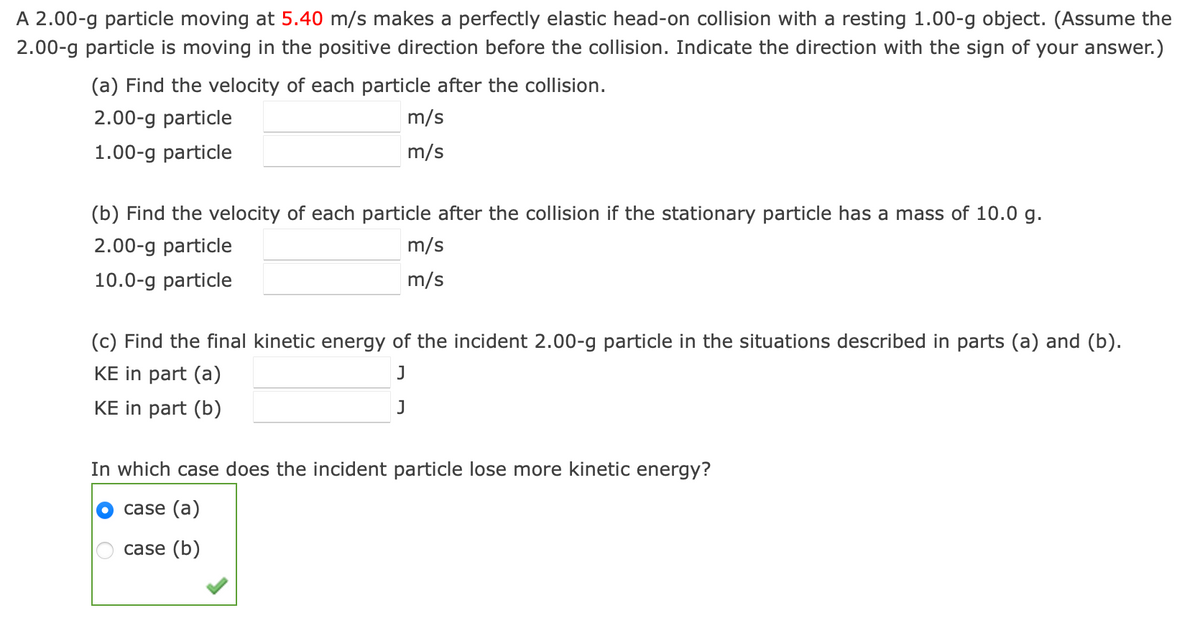A 2.00-g particle moving at 5.40 m/s makes a perfectly elastic head-on collision with a resting 1.00-g object. (Assume the 2.00-g particle is moving in the positive direction before the collision. Indicate the direction with the sign of your answer.) (a) Find the velocity of each particle after the collision. 2.00-g particle 1.00-g particle m/s m/s (b) Find the velocity of each particle after the collision if the stationary particle has a mass of 10.0 g. 2.00-g particle 10.0-g particle m/s m/s (c) Find the final kinetic energy of the incident 2.00-g particle in the situations described in parts (a) and (b). KE in part (a) KE in part (b) J J In which case does the incident particle lose more kinetic energy? case (a) case (b)
A 2.00-g particle moving at 5.40 m/s makes a perfectly elastic head-on collision with a resting 1.00-g object. (Assume the 2.00-g particle is moving in the positive direction before the collision. Indicate the direction with the sign of your answer.) (a) Find the velocity of each particle after the collision. 2.00-g particle 1.00-g particle m/s m/s (b) Find the velocity of each particle after the collision if the stationary particle has a mass of 10.0 g. 2.00-g particle 10.0-g particle m/s m/s (c) Find the final kinetic energy of the incident 2.00-g particle in the situations described in parts (a) and (b). KE in part (a) KE in part (b) J J In which case does the incident particle lose more kinetic energy? case (a) case (b)
Physics for Scientists and Engineers, Technology Update (No access codes included)
9th Edition
ISBN:9781305116399
Author:Raymond A. Serway, John W. Jewett
Publisher:Raymond A. Serway, John W. Jewett
Chapter9: Linear Momentum And Collisions
Section: Chapter Questions
Problem 9.91AP: A 2.00-g particle moving at 8.00 m/s makes a perfectly elastic head-on collision with a resting...
Related questions
Question

Transcribed Image Text:A 2.00-g particle moving at 5.40 m/s makes a perfectly elastic head-on collision with a resting 1.00-g object. (Assume the
2.00-g particle is moving in the positive direction before the collision. Indicate the direction with the sign of your answer.)
(a) Find the velocity of each particle after the collision.
2.00-g particle
1.00-g particle
m/s
m/s
(b) Find the velocity of each particle after the collision if the stationary particle has a mass of 10.0 g.
2.00-g particle
10.0-g particle
m/s
m/s
(c) Find the final kinetic energy of the incident 2.00-g particle in the situations described in parts (a) and (b).
KE in part (a)
KE in part (b)
J
J
In which case does the incident particle lose more kinetic energy?
case (a)
case (b)
Expert Solution
This question has been solved!
Explore an expertly crafted, step-by-step solution for a thorough understanding of key concepts.
This is a popular solution!
Trending now
This is a popular solution!
Step by step
Solved in 2 steps

Recommended textbooks for you

Physics for Scientists and Engineers, Technology …
Physics
ISBN:
9781305116399
Author:
Raymond A. Serway, John W. Jewett
Publisher:
Cengage Learning

Physics for Scientists and Engineers with Modern …
Physics
ISBN:
9781337553292
Author:
Raymond A. Serway, John W. Jewett
Publisher:
Cengage Learning

Principles of Physics: A Calculus-Based Text
Physics
ISBN:
9781133104261
Author:
Raymond A. Serway, John W. Jewett
Publisher:
Cengage Learning

Physics for Scientists and Engineers, Technology …
Physics
ISBN:
9781305116399
Author:
Raymond A. Serway, John W. Jewett
Publisher:
Cengage Learning

Physics for Scientists and Engineers with Modern …
Physics
ISBN:
9781337553292
Author:
Raymond A. Serway, John W. Jewett
Publisher:
Cengage Learning

Principles of Physics: A Calculus-Based Text
Physics
ISBN:
9781133104261
Author:
Raymond A. Serway, John W. Jewett
Publisher:
Cengage Learning

University Physics Volume 1
Physics
ISBN:
9781938168277
Author:
William Moebs, Samuel J. Ling, Jeff Sanny
Publisher:
OpenStax - Rice University

Glencoe Physics: Principles and Problems, Student…
Physics
ISBN:
9780078807213
Author:
Paul W. Zitzewitz
Publisher:
Glencoe/McGraw-Hill

College Physics
Physics
ISBN:
9781305952300
Author:
Raymond A. Serway, Chris Vuille
Publisher:
Cengage Learning